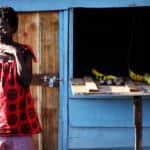Hooked on Sustainable Fish? Great – Now Let’s Help Fishers Who Net Them
“Conserve and sustainably use the oceans, seas and marine resources for sustainable development.” – Sustainable Development Goal (SDG) 14
“The risks of overfishing and unsustainable natural resource use are tending to increase. … Pollution, environmental degradation, climate change, diseases and natural and human-induced disasters add to the threats to fish workers’ livelihoods. Shrinking catches and declining fish stocks … are particularly affecting small-scale capture fishing communities in many developing countries.” – Food and Agriculture Organization of the United Nations (FAO)
Earlier this month, we joined a diverse group of organizations – NGOs, seafood importers and sellers, and fishers’ associations, among others – at the Americas Fisheries and Aquaculture* Tradeshow & Forum in Costa Rica. The event was organized by the Sustainable Fisheries Partnership (SFP), which is working toward building healthy marine and aquatic environments by reshaping corporate responsibility in the seafood industry, and convenes its corporate partners and other key seafood industry stakeholders at this annual forum to discuss seafood sustainability initiatives, social issues and other topics.
We were there representing the Clinton Giustra Enterprise Partnership (CGEP), an initiative of the Clinton Foundation, which recognizes the critical role that artisanal fishers and fish farmers play in the fisheries sector. An estimated 56.6 million people were engaged in fishing and fish farming in 2014 and an additional 140 million people are employed along the value chain, from harvesting to distribution. Small-scale fishing operations play a critical role in supporting rural livelihoods, contributing to food security and alleviating poverty. However, many artisanal fishers and fish farmers in developing countries face multiple challenges which limit their opportunities to earn decent incomes: the inability to afford the purchase of inputs or to invest in fishing vessels and technology, lack of cold chains and proper storage, and poor access to formal markets.
Recognizing these challenges, CGEP has built social businesses, branded Acceso, in El Salvador and Colombia that train fishers and fish farmers to adopt sustainable practices. For example, we’re outfitting fishers with gear that reduces bycatch (fish or other marine creatures caught unintentionally). We’re also introducing new technologies, like ones that help map fish stocks in the ocean, and are providing financing for the purchase of inputs like fish food.
But that’s just half the story. We then purchase fish and seafood directly from these fishers at fair prices, oversee processing and logistics, and sell it to supermarkets, restaurants and other retailers. It’s a distribution chain that would have otherwise been nearly impossible for these artisanal fishers and fish farmers to tap into; we’re improving their livelihoods through market access. This is an extension of our work with farmers in El Salvador, Colombia, and other countries.
At the forum, we joined an ecosystem of like-minded organizations and seafood industry leaders, all learning from each other about what’s working in the space, as well as ongoing challenges.
Cross-sector collaboration and engagement
As the seafood value chain involves many stakeholders, the best way to advance sustainability efforts is through partnerships and alignment on what needs to be done. As noted by SFP CEO Jim Cannon, “Our goal is to mobilize the majority. There is great diversity, from the smallest fisher to the world’s largest retailer, and everyone plays a role in improvement. Support those making a difference.” We learned about the work of organizations such as FishWise, a seafood consultancy that works with seafood companies on promoting sustainability through environmentally and socially responsible business practices, and Sea Pact, a group of leading North American seafood companies dedicated to continuous improvement of social, economic and environmental responsibility throughout the global seafood supply chain.
Growing emphasis on consumer-driven transparency, data
Consumers are increasingly conscious of the impact of their purchases and when faced with a choice between multiple products, often purchase ones that demonstrate a social or environmental benefit. Consumer interests coupled with organizations’ efforts to ensure seafood supplies for future generations has resulted in a growing number of certifications, standards and improvement projects to ensure responsible and sustainable fishing practices. Some of the more widely known standards in the industry are the Marine Stewardship Council certification, Best Aquaculture Practices certification and Monterey Bay Aquarium seafood recommendations.
New standards are still being developed. For example, Fair Trade USA recently developed a seafood certification program with the aim of benefiting small-scale fishers and their communities. Additionally, stakeholders often partner to develop Fishery or Aquaculture Improvement Projects (FIPs or AIPs) that focus on fishery improvements to enhance sustainability. We heard about experiences with FIPs from organizations such as The Nature Conservancy and the Center for Development and Sustainable Fisheries.
On the data front, new technologies are being developed to assist companies with seafood traceability, which also helps to combat illegal, unreported and unregulated fishing. Websites such as FishSource and Fishery Progress provide data that allows companies to be informed on and to purchase from sustainable fisheries. It is an ongoing challenge for companies to decide which standard(s) to adopt, and an exercise that CGEP is undertaking as well.
How to fairly allocate the benefits
While the long-term value of improving fishing practices is undisputed, certification or FIPs are multi-year projects that can cost up to hundreds of thousands of dollars. There are no written rules about who should cover these costs and they can be daunting tasks for small-scale fisheries without adequate financial and operational support. Customers are often willing to pay more for responsible products. But this premium often benefits the retailers, not the fishers and fish farmers. How do we ensure fishers and fish farmers reap the benefits of these premiums, likely in the form of higher prices for their products, in relation to the time and money they invest for certification or FIPs? At the same time, the complexities for small-scale fisheries to obtain certification may deter seafood companies from working with them, although the social impact from a food security, nutrition and livelihood perspective of working with them is greater.
At the forum, we learned about several organizations working to make the process more equitable. Chef’s Trading, a seafood importer, charges their buyers a small premium on their seafood, which they reinvest in FIPs. Sea Delight, also an importer, supports fisheries through implementation of FIPs and financial contribution toward implementation costs. Fair Trade USA implements policies to ensure that Fair Trade premiums are channeled back toward fishing communities. Funding to support certification efforts and FIPs is also available from organizations such as the Resources Legacy Fund. While these practices are helping, there’s more work to be done. Stakeholders must continue to work toward supporting small-scale fishers and fish farmers. (Note: For additional reading on the role of the seafood industry and social development, refer to this report presented by SFP, the UNDP and Oxfam.)
As stakeholders in the fisheries and seafood sector work toward a common goal of preserving our oceans and fisheries, we know that continued collaboration and informed decision-making is the way to get there. As CGEP continues our work in this space, we are excited to continue working with retailers, nonprofits and other organizations to exchange best practices and learnings – all to ensure sustainable livelihoods for artisanal fishers and fish farmers.
*Aquaculture is the formal term for fish farming, which provides half of all fish for human consumption, according to the FAO.
Alethia Kang is the associate director of strategic development and communications for the Clinton Giustra Enterprise Partnership, an initiative of the Clinton Foundation; Andres Baiza is the general manager of Acceso El Salvador, a farmer services and aggregation business working with Salvadorian farmers, fishers and fish farmers, built by the Clinton Giustra Enterprise Partnership.
Photos by Jayne Quan, Clinton Foundation
- Categories
- Environment




